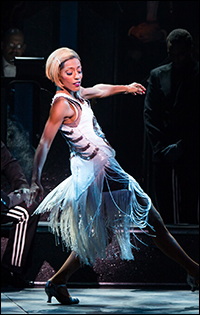
A willowy figure steps into the light. Graceful and impeccably styled in the latest creation from one of the world's top fashion designers. No, she's not on a catwalk, nor is she a model. She's a performer.
Recently, so many fashion designers have worked on theatre and ballet projects, that the line between catwalk and stage has become increasingly diaphanous. With ESosa's designs colorfully illustrating the passing decades in Broadway's Motown and Lady Day at Emerson's Bar and Grill, beaded finery by Isabel Toledo sparkling on the dancers of After Midnight, and fashion's enfant terrible Jean Paul Gaultier bringing the glam to Grimm in Ballet Preljocaj's Snow White at the David H. Koch Theater, buy a ticket to a show and you might think you're in the tents of New York's fashion week.
They are in good company. Throughout history fashion designers have been drawn to the theatricality of the stage. From Chanel designing costumes for Little Miss Bluebeard in 1923, and through to Halston, Bill Blass, Oscar de la Renta, Isaac Mizrahi and others, couturiers have sometimes opted for dressing characters over customers.
This shift brings its own set of challenges. In the offstage world an item of clothing rarely has to survive being worn (and washed) eight times a week, let alone athletically danced in. "So many tailoring and dressmaker secrets are involved in pulling this off," said Isabel Toledo, whose shimmering art deco gowns and elegant tailcoats in After Midnight must remain pristine through Warren Carlyle's energetic choreography. "To see one of my gowns dance through the air and then do a split and bounce back and look gorgeous is a real thrill."
Toledo also found she had to shift how she imagines her designs. In fashion, she favors adaptability: "I like to design clothes that are versatile enough that every woman can transform them and wear them according to her personal style," said Toledo (whose frequent customer Michelle Obama wore a Toledo design for husband Barack Obama's first inauguration). When designing for the stage, however, "costumes have to very specifically help define the character, nothing should be extra, no caprice allowed." As Mizrahi put it, "you're always trying to help an actor bring a part alive." Or, in other words, "you're always the shrink."
| |
 |
|
| Karine Plantadit in After Midnight | ||
| Photo by Matthew Murphy |
But realism isn't always the ideal. Contemporary choreographer Angelin Preljocaj's spin on Snow White, with a score by Mahler, features costumes by Jean Paul Gaultier. As befits the legendary designer, who made Madonna's décolletage into torpedoes with his famous cone bra bustier, Gaultier's costumes for Snow White lean more towards Dominatrix than Disney. The evil stepmother struts the stage in thigh-high boots, a caged high bodice and a patent leather cape. But designing for a theatrical experience isn't far from Gaultier's work at his own couture label. "When I design for myself, for Jean Paul Gaultier," he said, "I am a director, I write the script, I do the casting. I have complete control." For fashion's longtime provocateur, working with artists like Preljocaj is a welcome challenge: "It's a breath of fresh air for me to collaborate with choreographers or film directors or music divas and see how I can put myself in their world and do something that corresponds to them," he said. And if his fashions influence his stage design, the opposite is also true: "Theatre and ballet are always a great source of inspiration for me."
For Isaac Mizrahi, theatre is far more than an inspiration. There is perhaps no designer more well-rounded as a theatre artist. In addition to designing costumes for the theatre, ballet, and opera, Mizrahi has designed sets, directed and even written and starred in his own one-man cabarets. The multi-hyphenate, who is next designing and directing a production of The Magic Flute at the Opera Theatre of Saint Louis, feels that the difference between costume and fashion is slight; "the draw is the same in both cases," he said. "It's about bodies and textiles and personalities and an overall look." But when it comes down to it, he said, "it's all theatre."











